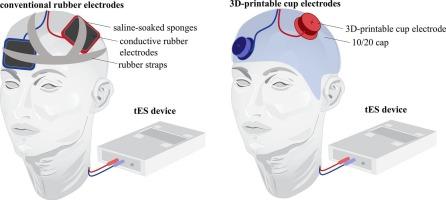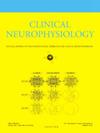3D-printable stimulation electrodes to improve precision, reproducibility, and reliability of transcranial electric current stimulation
IF 3.6
3区 医学
Q1 CLINICAL NEUROLOGY
引用次数: 0
Abstract
Objective
Transcranial electric stimulation (tES) refers to noninvasive neuromodulation techniques that apply a low-amplitude electric current through scalp electrodes to modulate brain activity. Conventional scalp electrodes are made of conductive rubber and are embedded in saline-soaked sponges, held in place using non-conductive rubber straps. Precisely positioning the electrodes at the desired location is challenging, and maintaining their position is equally difficult. In addition, as sponges are prone to drying out during prolonged use, they can compromise the electrode’s conductivity and therefore cause fluctuations in connectivity.
Methods
To tackle these limitations of conventional tES electrodes, we designed new 3D-printable gel-filled tES electrodes.
Results
We developed electrodes in various sizes ranging in radius from 12 mm to 30 mm to allow a wide variety of options regarding stimulation parameters and electrode montages. By integrating the electrodes into a 10–20-cap, they can be positioned precisely according to the 10–20 coordinate system and the cap holds them in place, even during significant movements.
Conclusions
Sharing our 3D-printable electrode designs as open-source can improve precision, reproducibility, and reliability of tES.
Significance
In this way, we aim to tackle the reliability and reproducibility issues in the tES field as they provide an accessible and reliable tool to apply tES in humans.

3d打印刺激电极,以提高经颅电流刺激的精度,再现性和可靠性
目的经颅电刺激(tES)是一种无创神经调节技术,通过头皮电极施加低振幅电流来调节大脑活动。传统的头皮电极是由导电橡胶制成的,嵌入在盐水浸泡的海绵中,用不导电的橡胶带固定。将电极精确定位在所需位置是一项挑战,保持其位置同样困难。此外,由于海绵在长时间使用过程中容易变干,它们可能会损害电极的导电性,从而导致连通性的波动。方法为了解决传统te电极的这些局限性,我们设计了新的3d打印凝胶填充te电极。我们开发了半径从12mm到30mm的各种尺寸的电极,以允许在刺激参数和电极蒙太奇方面有多种选择。通过将电极集成到10-20帽中,它们可以根据10-20坐标系精确定位,即使在重大运动期间,帽也可以将它们固定在适当的位置。结论将我们的3d打印电极设计作为开源共享,可以提高te的精度、可重复性和可靠性。通过这种方式,我们的目标是解决tES领域的可靠性和可重复性问题,因为它们为将tES应用于人类提供了一个可访问和可靠的工具。
本文章由计算机程序翻译,如有差异,请以英文原文为准。
求助全文
约1分钟内获得全文
求助全文
来源期刊

Clinical Neurophysiology
医学-临床神经学
CiteScore
8.70
自引率
6.40%
发文量
932
审稿时长
59 days
期刊介绍:
As of January 1999, The journal Electroencephalography and Clinical Neurophysiology, and its two sections Electromyography and Motor Control and Evoked Potentials have amalgamated to become this journal - Clinical Neurophysiology.
Clinical Neurophysiology is the official journal of the International Federation of Clinical Neurophysiology, the Brazilian Society of Clinical Neurophysiology, the Czech Society of Clinical Neurophysiology, the Italian Clinical Neurophysiology Society and the International Society of Intraoperative Neurophysiology.The journal is dedicated to fostering research and disseminating information on all aspects of both normal and abnormal functioning of the nervous system. The key aim of the publication is to disseminate scholarly reports on the pathophysiology underlying diseases of the central and peripheral nervous system of human patients. Clinical trials that use neurophysiological measures to document change are encouraged, as are manuscripts reporting data on integrated neuroimaging of central nervous function including, but not limited to, functional MRI, MEG, EEG, PET and other neuroimaging modalities.
 求助内容:
求助内容: 应助结果提醒方式:
应助结果提醒方式:


